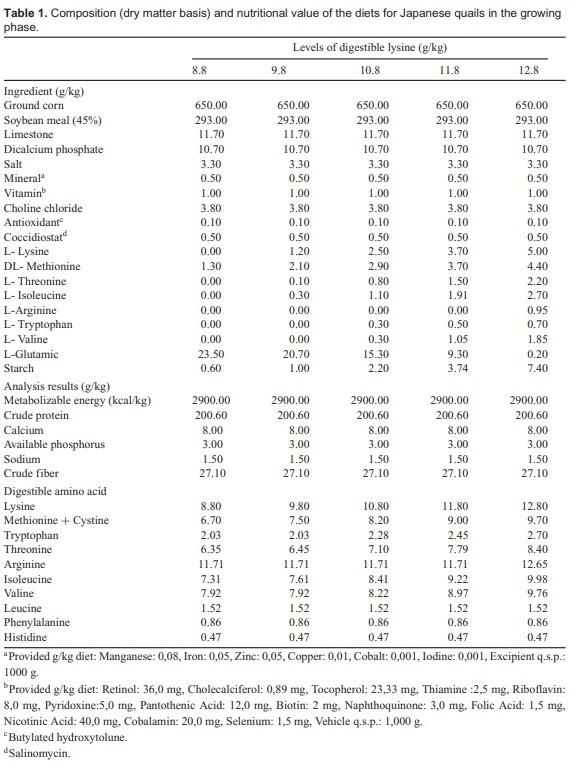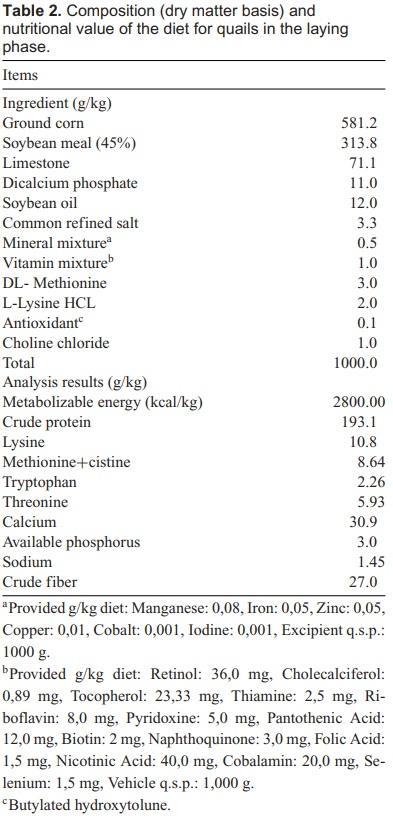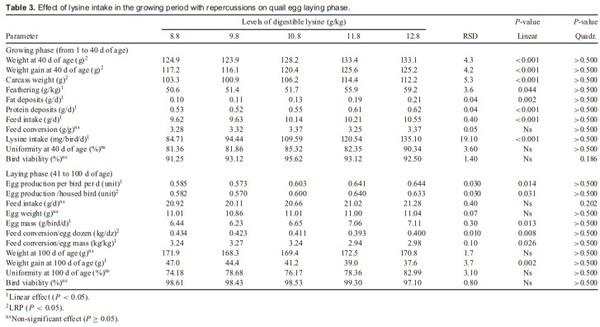DESCRIPTION OF PROBLEM
Quail egg production is an important market for human consumption in some countries, including Brazil, China, and Japan. Studies are very important to enable a rational production for information on setting a correct feeding program for these birds. The level of a single essential amino acid that is either deficient or in excess may result in a diet that does not optimize the economic efficiency of a laying bird’s production system. The optimal amino acids levels are not the same for the maximization of weight gain, feed conversion, or muscle development [1,2]. Lysine is considered an essential amino acid. It is synthesized in the tissues at an amount that is not sufficient for meeting the birds’ needs, therefore making it necessary to use the lysine present in the protein found in the feed or in other synthetic sources, such as L-lysine HCl. L-lysine HCl presents a L-lysine activity of 784 g/kg, and 100% of digestibility [3]. As it is considered a standard in ideal protein, lysine has been used as a control to update the needs of other amino acids through simple ratios [4,5].
The main function of the lysine is in the synthesis of protein [6,7]. The main functions of lysine for growing birds are the formation of muscle tissues, bone, and carnitine precursors. The glycosylation and hydroxylation of lysine have important biochemical functions in the formation of the organic matrix of the growing bone. The cross-links between lysine and hydroxilysine residues stabilize the fiber structure of the collagen and increase mechanical bone strength. The initial phase of the bird’s life is characterized by high body development, a high metabolic rate, and a low feed intake. An inadequate lysine level in the diet may affect the growth of the birds and lead to a bad conformation of the carcass, therefore presenting an inadequate weight at sexual maturity at the end of the growth phase.
For the complete maturation of quails, there need to be feed programs that maximize growth rate and body development [8], allowing the birds to reach an ideal weight at sexual maturity, enabling a uniformity of the flock and assuring normality in the production stage. This is because nutritional conditions set during the growing phase influence a bird’s performance in the production stage. However, most studies have been carried out to determine the nutritional requirements of laying birds in the production stage, and little work has been produced to determine the requirements for the growing stage [9]. References on the Lys needs of quail chicks yet are limited [10]. Thus, the objective was to determine the digestible lysine requirement for the growth of the Japanese quail (Coturnix japonica), based on the ideal protein, until the early stage of production.
MATERIALS AND METHODS
This study was carried out in strict accordance with the recommendations in the Guide for the Care of Brazilian Council of Experiments using Animals. The protocol was approved by the Committee on the Ethics of Animal Experiments of the Department of Animal Science, Universidade Federal de Vicosa (Permit Number: 13/2011). All efforts were made to minimize suffering.
Growing Phase (From One to 40 d of Age)
A total of 1,000 one-day-old, female, Japanese quail species (Coturnix japonica), with a body weight of 7.79 ± 0.21 g were distributed randomly with 5 levels of digestible lysine, with 20 birds per cage (an experimental unit) and 10 replicates. Each cage measured 50 cm in width and 50 cm in length with a wooden floor covered by 4 cm of shavings, providing an area of 125 cm2/bird. Sixty-watt light bulbs were placed in each cage and were used to warm the birds until they reached 15 d of age. The light bulbs were turned on 2 h before the arrival of the flock to reach the required installation temperature and to provide warmth for the birds.
The cages were set inside a shed. They were made of galvanized wire and covered and managed under a raffia curtain for the first 15 d of the birds’ lives, to keep the cage warm. This also was achieved by hanging curtains on the laterals of the shed. In each cage, one glass pressure drinker per cage was used. Right after being housed, the quails were guided to the presence of water. From the age of 12 d, glass pressure drinkers were replaced by nipple drinkers; again there was one drinker per cage. Tray feeders were used with a diameter of 18 cm, with one per cage, until the birds were 12 d of age. Then, the feeders were replaced by trough feeders, placed in the front section of the experimental units.
The units were illuminated 24 h a d by artificial light (the same light bulbs used for warmth) until the birds were 15 d of age, and then only natural light was used until the birds were 40 d of age, to avoid the early sexual maturity of the quails. The temperature and humidity inside the shed were controlled by measurements made by maximum and minimum thermometers, wet and dry bulbs, and also based on the behavior of the quails. Temperature data were recorded once a d at 4:00 p.m. and humidity was recorded twice a d at 9:00 a.m. and 3:00 p.m.
The birds were fed a basal diet that was deficient in digestible lysine and based on corn and soybean meal, containing 200.6 g

CP/kg, 2900.00 kcal/kg ME, and 8.8 g digestible lysine /kg (Table 1). This basal diet was supplemented with L-lysine HCl (78.4%), replacing glutamic acid, which corresponded with the levels of digestible lysine of 8.8 g/kg (no L-lysine supplementation), 9.8 g/kg, 10.8 g/kg, 11.8 g/kg, and 12.8 g/kg. The feed ingredients were analyzed for essential amino acids. The diets were isocaloric and isonitrogenic. Except for crude protein, all the necessary nutritional requirements were met, including the ratios between the amino acids proposed by the NRC [11]. The ratio between methionine plus cystine digestible and digestible lysine, digestible threonine, and digestible lysine, and the ratio between digestible tryptophan and digestible lysine were used according to Lima et al. [12] and to Lima et al. [13]. To guarantee the lack of deficiencies, 3% was added to each amino acid requirement, except for digestible lysine. When the quails reached 40 d of age, they had their beaks trimmed, before being moved to egg laying cages.
Laying Phase (From 41 to 100 d of Age)
To evaluate the repercussions in the growth and development of quails in the laying stage, the birds were moved to laying cages at 41 d of age, and the same birds from each experimental unit in the growing stage were kept in those cages. Birds were kept in galvanized wire cages (an experimental unit), in a ladder arrangement, with the dimensions of 50 × 34 cm and provided with trough feeders that were placed in the front section of each cage with corresponding nipple drinkers. Each experimental unit, until the growing phase, provided a minimum of 106.2 cm2 /bird if there was no mortality in the respective experimental unit. Light was provided for 16 h a d until the experimental period was over. The light supply was controlled by a timer, allowing the lights to be turned on and off at night and in the early h of the morning, in accordance with the procedure adopted in commercial poultry farms.
The temperature and humidity inside the experimental shed were controlled, based on the measurements provided by the maximum and minimum thermometers, by the wet and dry bulbs, and also by the behavior of the quails. Temperature data were recorded once a d at 4:00 p.m. and humidity was recorded twice a d, at 9:00 a.m. and at 3:00 p.m. Quails were fed a single diet based on corn and soybean (Table 2) in the laying stage. The feed ingredients were analyzed for essential amino acids. This diet was formulated to meet the nutritional requirements presented in Rostagno et al. [14].
Evaluated Parameters
The feed intake was measured weekly. For those birds that died, their average intake was subtracted and corrected, resulting in the real average intake for the experimental unit. Feed conversion in the growing phase was calculated
by dividing feed intake by the body weight gain accumulated in the period (kg of diet /kg weight gain). All the birds were weighed at the beginning and at the end of the growing phase and at the laying phase, so as to determine the exact weight at 40 and 110 d of age, and subsequently the weight gain of the birds in each phase.
To determine bird viability in the growing and laying phases, the number of dead quails was recorded daily. The mortality of the birds was subtracted from the total number of birds in the growing and laying phases. The values obtained at the end of the period were converted into a percentage. All the birds were weighed to determine the uniformity in each experimental unit, in the growing and laying phases, and these weights were expressed as a percentage of the individual weights that were within the 10% of the mean of the unit.
On reaching 40 d of age, 2 birds that were within the average weight of each experimental unit were slaughtered. Birds were dry plucked and the feathers were weighed for feathering calculations. Next, the birds were eviscerated, cooled, frozen, and ground to determine the contents of the dry matter, ether extract, and crude protein according to the Association of Official Analytical Chemists [15]. Body fat and protein deposits were calculated by slaughtering an additional group of 50 one-day-old quails. They were compared to body fat and protein deposits of the quails slaughtered at the end of the growing phase. For the calculation of body fat and protein deposits, the value found in the sample was compared with the average weight of the live animal in each experimental unit, according to Pinto et al. [9].
To obtain the average egg production in the period, the number of produced eggs, including the cracked, the broken, and the abnormal eggs, were expressed over the number of birds in the period (egg produced/bird/d) and over the number of birds housed in the beginning of the experiment (egg produced/housed bird). Feed conversion per dozen eggs was evaluated and expressed by the total feed intake in kilograms divided by a dozen eggs produced (kg/dz), and the conversion per egg mass, which was achieved by dividing feed intake into kilograms by the mass of eggs produced in kilograms (kg/kg). All the intact eggs in each replicate, produced in the last 3 d of each wk during the complete experimental period, were weighed and the total weight obtained was divided by the number of eggs used in the weighing. The average weight of the eggs was multiplied by the total number of eggs produced in the period. This total mass was divided by the total number of birds and also by the number of d in the period and expressed in grams of egg per bird, per day (g egg/bird/d).
Statistical Analysis
The effects of the treatment were estimated by an analysis of the variables, by using linear and quadratic regression models and including the broken line model (LRP), in accordance with the best adjustment obtained for each variable and by considering the biological behavior of the birds. The parameters were submitted for statistical analyses by the software SAS [16].
RESULTS
The air temperature inside the experimental shed for the period one to 7, 8 to 14, 15 to 40, and 41 to 100 d of age of the birds was 38.8 ± 1.2, 36.2 ± 0.6, 32.4 ± 1.6, and 28.6 ± 2.0 (maximum); 31.1 ± 4.1, 32.2 ± 3.1, 23.2 ± 2.5, and 20.7 ± 1.8 (minimum), respectively. The relative humidity for the period one to 7, 8 to 14, 15 to 40, and 41 to 100 days of age of the birds was 76.5 ± 4.5, 71.7 ± 6.4, 76.3 ± 3.7, and 79.0 ± 4.5 to 9:00 a.m., and was 59.5 ± 10.5, 54.0 ± 4.5, 56.0 ± 10.0 and 68.6 ± 8.9 to 3:00 p.m., respectively.
Although the body weight (P < 0.001) and the weight gain of the birds (P < 0.001), carcass weight (P < 0.001), egg production per housed bird (P = 0.031), and feed conversion per dozen eggs (P = 0.008) had linearly increased, the LRP was in best agreement with the data (Table 3). The increase in the levels of digestible lysine provided a greater weight gain in the birds at 40 d of age until to 12.2 and 12.1 g of lysine/kg, according to the following equations: weight at 40 d of age: Yˆ = 97.1626 + 29.5800 X, R2 = 0.80; y = 12.16; weight gain until 40 d of age: Yˆ = 89.2790 + 297000 X, R2 = 0.80; y = 12.09, respectively
Carcass weight increased as levels of lysine increased up to 11.85 g according to the following equation Yˆ = 66.5298 + 38.5900 X, R2 = 0.72; y = 11.85. Egg production per housed bird increased to 12.03 g of lysine/kg, according to the equation Yˆ = 38.8720 + 20.3500 X, R2 = 0.75; y = 12.03; and feed conversion per dozen eggs increased to the level of 11.43 g of lysine/kg, according to the equation: Yˆ =0.554300 – 0.135000 X, R2 = 0.99; y = 11.43. An increasing linear effect (P = 0.044) occurred in the growing phase for feathering (Yˆ = 3.03240 + 0.217000 X, R2 = 0.87). There was also a linear increase (P < 0.01) for fat deposits in the carcass (P = 0.002; Yˆ = −0.176000 + 0.0300000 X, R2 = 0.93), crude protein deposits in the carcass (P < 0.001), equation: Yˆ = 0.274400 + 0.270000
X, R2 = 0.86, feed intake (P < 0.001; Yˆ = 7.39480 + 0.244000 X, R2 = 0.93), and lysine intake (P < 0.001; Yˆ = − 28.1544 + 12.6880 X, R2 = 0.99).
8.1544 + 12.6880 X, R2 = 0.99). A linear increase occurred in the laying phase for egg production per bird, per d (P = 0.014; Yˆ = 40.8788 + 1.85900 X, R2 = 0.83) and egg mass (P = 0.013; Yˆ = 4.3544 + 0.217000 X, R2 = 0.80) and a linear decrease occurred (P = 0.02) in the function of the levels of lysine for the weight gain of birds until 100 d of age (Yˆ = 67.9100 – 2.41000 X, R2 = 0.98) and the feed conversion per egg mass linearly decreased (P = 0.026; Yˆ = 4.05200 – 8.50000 X, R2 = 0.71). Levels of lysine in the growing phase did not affect (P > 0.05) the feed conversion and the uniformity of the birds at 40 d of age. Additionally, in the laying phase, they did not affect the feed intake, egg weight, bird viability, and the weight and uniformity of the birds at 100 d of age.
DISCUSSION
In the growing phase, quails need an ideal thermo-hygrometric environment of 38◦C and relative air humidity of 65% in the first wk of life; in the second wk of life, these values change to 32°C and to 60% of relative humidity. From 15 d of life the birds no longer require artificial heating because they present good feathering with maximum and minimum temperatures of 31°C and 19°C and at 60 and 65% of relative humidity. In the adult phase, the thermal comfort range of quails is between 18 and 22°C and the relative air humidity is 65 to 70% [17,9]. By considering the information found in the literature, the measurements on temperature and humidity, as well as the behavior of the quails, it could be concluded that the birds were in an adequate thermo-hygrometric environment.
Heavier quails showed higher egg production per bird, per d. However, they also showed a higher feed intake in the growing phase. Lysine intake increased due to a greater feed intake and to the increase in the levels of lysine in the diet. On the other hand, there were no differences in the feed intake in the laying phase, but birds that were offered lower lysine levels and consumed less feed in the growing phase needed to reach an adequate weight at sexual maturity similar to the others, therefore presenting a greater weight gain until 100 d of age, with deviation in the nutrients for body conformation and, as a consequence, impairing egg production.
Ton et al. [18] found that the body weight of quails at 35 d of age linearly increased as levels of digestible lysine increased. Nevertheless, Moura et al. [19] did not find any effect of the total lysine levels on any of the performance traits of growing Japanese quails. According to those authors, although quails showed their body mass as 10 times higher in the first 21 d, this gain in mass occurs due to the greater synthesis of bone tissue instead of muscle hypertrophy. The dietary level of lysine is also related to the chemical composition of the carcass. Therefore, the high levels of this amino acid provide higher percentages of protein deposits [20]. The development of the pectoral muscle is influenced specifically by the lysine, and the lysine balance has a more important effect than the feed intake [21,22]. Considering the function of the lysine in the formation of the bone and muscle tissue for growing birds and because this amino acid is the majority in muscle proteins, a level of 11.85 g/kg therefore provides the greatest carcass weight of the quails; it is subsequently related to the aptitude of these birds until sexual maturity. Quails fed a diet containing 11.85 g of lysine/kg presented a ratio between fat and protein deposits of 0.31, whereas birds fed diets with 12.8 g of lysine/kg obtained a ratio of 0.34 between fat and protein.
The lower ratio between the deposits of fat and protein in the carcass, which occurred in quail, fed 8.8, 9.8, and 10.8 g lysine/kg provided egg production per bird, per d, was considerably lower than birds fed 11.8 and 12.8 g lysine /kg. However, egg production per bird, per d was only 0.37% higher in quails that consumed diets with 12.8 g of lysine/kg, but the ratio between fat and protein was 8.85% higher than the ratio of fat and protein deposits in the carcass of birds fed 11.8 g of lysine/kg. Therefore, it can be inferred that the greater proportion of fat in the carcass could impair a bird’s performance as it gets older, providing a lower viability and, therefore, a lower egg production per bird, per d and mainly per housed bird, since egg production increased until to the level of 12.03 g of lysine/kg in the diet.
Total dietary protein and specific amino acids such as cystine, methionine, and lysine are among the nutritional factors associated with feather formation. Thus, lower levels of lysine in the diet caused a lower percentage of feathers in the quails. However, the lower feathering (percentage in relation to the live weight of the birds) is likely to be related to a higher weight in the body conformation of the quails with greater muscle protein deposits and bone formation associated with a greater availability of lysine in the diet. Grau et al. [23] suggested that lysine deficiency during the critical growing stages in turkeys, hens, and Japanese quails would result in white feathers instead of the normal dark bronze ones, a fact that was not observed in the present study.
Even though feed conversion in the growing stage had not been influenced by the levels of lysine, the level of 11.8 g of lysine/kg resulted in a feed conversion as much as 3.6% higher (in absolute values) than the level of 12.8 g of lysine/kg. Egg mass increased with levels of lysine increased, due to the increase in egg production per bird, per d, because egg weight did not change. Thus, feed conversion ratio per egg mass showed the same result, corroborating with the already mentioned fact that birds ingesting diets with lower levels of lysine in the growing phase had used some of the dietary nutrients for body conformation. The improvement in feed conversion per dozen eggs followed the increase in their production. However, because of the behavior for diet intake in the laying phase, feed conversion ratio was optimized up to the level of 11.43 g of lysine/kg.
An adequate level of lysine is needed for the growing phase since its marginal levels may provide a less uniformity of the flock, therefore compromising the final performance result [24]. Even though uniformity and bird viability had not showed differences in function of the level of lysine, diets with 11.85 g of lysine/kg provided a greater carcass weight, improving the performance of quails in the laying stage. According to Lewis and Morris [25] mean age at first egg, egg production in a given period, mean body weight at first egg, and mean egg weight increase linearly. These ratios are steeper for age at first egg in turkeys, partridges, and quails.
The NRC [11] recommends the level of 13.0 g/kg. Svach et al. [26] suggested 13.7 g of total lysine/kg of diet with 260.0 g of crude protein/kg for quail at zero to 3 wk of age, and Shrivastav et al. [27] recommended the level of 13.0 g of total lysine/kg of diet with 270.0 g of crude protein/kg in the growing phase. Leeson and Summers [28] suggested the level of 13.0 g of total lysine/kg for a diet with 280 kg crude protein. Hajkhodadadi et al. [4] indicated that the NRC [11] Lys requirement of 13.0 g/kg (total basis) is not adequate from 21 to 42 d of age for female Japanese quails. Lys requirements of starting Japanese quails according Mehri et al. [8] may be at least 13.4 g/kg of diet for optimizing carcass attributes. Those values, on the basis of total and digestible amino acids, are higher than the ones determined in this study, which were similar to the ones suggested by Pinto et al. [9], i.e. 11.8 g of digestible lysine/kg. Moura [19] recommended a lower level of lysine, reporting that 9.0 of total lysine/kg met the requirements of the quail in the growing phase. More recently, the levels of 11.2 g digestible lysine/kg with 220.0 g of crude protein/kg had been suggested for quails in the growing phase [14]. The reduction from 240.0 g/kg of crude protein in the diet, recommended by the NRC [11], to 200.6 g/kg, by keeping the concept of ideal protein and the level of the lysine at 11.85 g/kg, was shown to be feasible and adequate to be used in diets for Japanese quails as a function of their genotype currently adopted in the production systems.
CONCLUSIONS AND APPLICATIONS
1. The level of 11.85 g of digestible lysine/kg of a diet, corresponding to the lysine intake of 120.5 mg/bird/d, provides a better carcass weight at the end of the growing phase and a satisfactory performance of Japanese quails in the laying phase.
2. The level of 11.85 g of digestible lysine/kg of a diet may minimize environmental pollution and optimize the economic efficiency for the quail egg industry, which will contribute to a better use of the productive potential of
Japanese quails.
This article was originally published in 2016 J. Appl. Poult. Res. 25:483–491. http://dx.doi.org/10.3382/japr/pfw030. This is an Open Access article under a Creative Commons license. 












.jpg&w=3840&q=75)